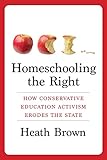Homeschooling the right : how conservative education activism erodes the state / Heath Brown.
Material type: TextDescription: 1 online resource (vi, 255 pages) : illustrationsContent type:
TextDescription: 1 online resource (vi, 255 pages) : illustrationsContent type: - text
- computer
- online resource
- 9780231548014
- LC40 .H664 2021
- COPYRIGHT NOT covered - Click this link to request copyright permission: https://lib.ciu.edu/copyright-request-form
| Item type | Current library | Collection | Call number | URL | Status | Date due | Barcode | |
|---|---|---|---|---|---|---|---|---|
 Online Book (LOGIN USING YOUR MY CIU LOGIN AND PASSWORD)
Online Book (LOGIN USING YOUR MY CIU LOGIN AND PASSWORD)
|
G. Allen Fleece Library ONLINE | Non-fiction | LC40 (Browse shelf(Opens below)) | Link to resource | Available | on1154856330 |
Includes bibliographies and index.
A theory of conservative freedom policy feedback -- The development of homeschool policy -- Design of homeschool policy and charter school -- The pillars of homeschooling -- Homeschooling organizational feedback and communications -- State and local mobilization and policy change -- Political behavior and community effects.
"Historic preservation is typically regarded as an elitist practice. In this view, designating a neighborhood as historic is a project by and for affluent residents concerned with aesthetics, not affordability. It leads to gentrification and rising property values for wealthy homeowners, while displacement afflicts longer-term, lower-income residents of the neighborhood, often people of color. Through rich case studies of Baltimore and Brooklyn, Aaron Passell complicates this story, exploring how community activists and local governments use historic preservation to accelerate or slow down neighborhood change. He argues that this form of regulation is one of the few remaining urban policy interventions that enable communities to exercise some control over the changing built environments of their neighborhoods. In Baltimore, it is part of a primarily top-down strategy for channeling investment into historic neighborhoods, many of them plagued by vacancy and abandonment. In central Brooklyn, neighborhood groups have discovered the utility of landmark district designation as they seek to mitigate rapid change with whatever legal tools they can. The contrast between Baltimore and Brooklyn reveals that the relationship between historic preservation and neighborhood change varies not only from city to city, but even from neighborhood to neighborhood. In speaking with local activists, Passell finds that historic district designation and enforcement efforts can be a part of neighborhood community building and bottom-up revitalization. Featuring compelling narrative interviews alongside quantitative data, Preserving Neighborhoods is a nuanced mixed-methods study of an important local-level urban policy and its surprisingly varied consequences"--
COPYRIGHT NOT covered - Click this link to request copyright permission:
There are no comments on this title.
